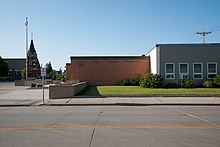Cavalier County, North Dakota
| Cavalier County, North Dakota | |
|---|---|

Cavalier County Courthouse
|
|
 Location in the U.S. state of North Dakota |
|
 North Dakota's location in the U.S. |
|
| Founded | July 8, 1884 |
| Seat | Langdon |
| Largest city | Langdon |
| Area | |
| • Total | 1,510 sq mi (3,911 km2) |
| • Land | 1,489 sq mi (3,856 km2) |
| • Water | 21 sq mi (54 km2), 1.4% |
| Population (est.) | |
| • (2015) | 3,828 |
| • Density | 2.7/sq mi (1/km²) |
| Congressional district | At-large |
| Time zone | Central: UTC-6/-5 |
| Website | cavaliercounty |
Cavalier County is a county located in the U.S. state of North Dakota. As of the 2010 Census, the population was 3,993. Its county seat is Langdon. The county was created by the 1873 territorial legislature and named for Charles Cavileer of Pembina (1818–1902), one of the earliest white settlers. The county was organized on July 8, 1884. It is south of the Canada–US border with Manitoba.
The city of Cavalier is in nearby Pembina County.
Cavalier County was created from the western part of Pembina County, North Dakota in 1873 and named by the Territorial Legislature for Charles Turner Cavileer (1818–1902), a well known fur trader, customs agent and postmaster. There is no explanation for the difference in the spelling of "Cavalier," though one placename historian suspects it was an attempt to Gallicize, or make the name appear French.
After petitioning the Territorial Governor for permission to organize the county, Patrick McHugh, W. Hudson Matthews, and L.C. Noracong met for the purpose on July 8, 1884. On July 26 the new county officials met for the second time and chose Noracong as Chairman of the Board with William H. Doyle and Matthews as Commissioners. The first Register of Deeds and County Clerk was McHugh. W.J. Mooney became the first Judge of Probate, Charles B. Nelson was the first Cavalier County Supt. of Schools, and Clarence Hawkes the first Sheriff. Cavalier took its current form in 1887 after the Territorial Legislature authorized an increase in size by taking a portion from Pembina County. The expansion added 15 new townships to the county.
The site of the new county seat was chosen at this meeting and named Langdon after Robert Bruce Langdon of Minnesota and official with the Great Northern Railroad. Langdon never visited the town, but reportedly donated a bell for the local school.
...
Wikipedia
